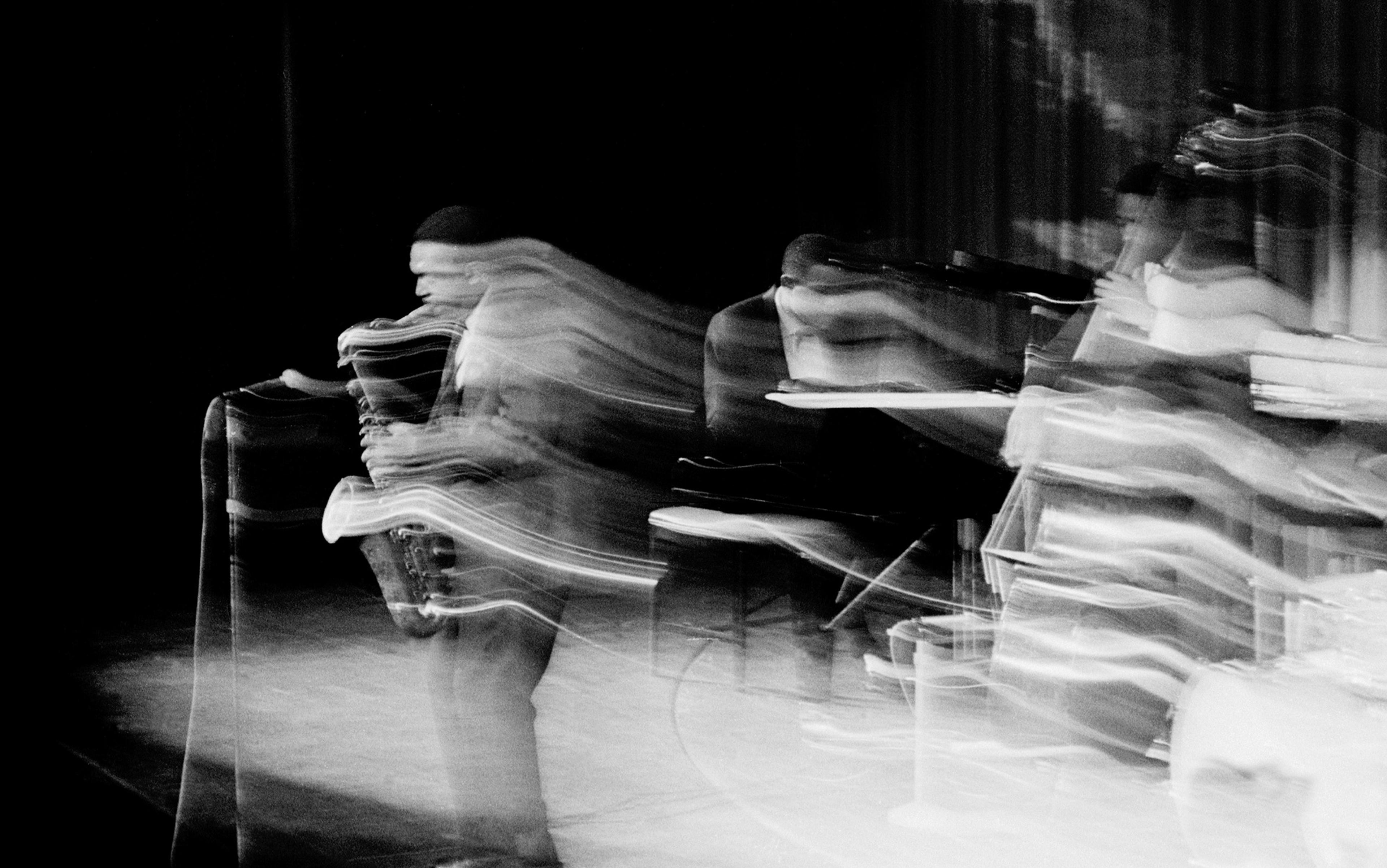Quantum physics is weird and counterintuitive. For this reason, the word ‘quantum’ has become shorthand for anything powerful or mystical, whether or not it has anything whatsoever to do with quantum mechanics. As a quantum physicist, I’ve developed a reflexive eyeroll upon hearing the word applied to anything outside of physics. It’s used to describe homeopathy, dishwasher detergents and deodorant.
If I hadn’t first heard of Quantum Music from a well-respected physicist, I would have scoffed the same way I did at the other ridiculous uses of the word. But coming from Klaus Mølmer it was intriguing. In the Quantum Music project, physicists and musicians worked together to unite ‘the mysterious worlds of quantum physics and music for the first time’. They developed a device that attaches to each key of a piano so that, when the pianist plays, the information is piped to a computer and synthesiser, which plays ‘quantum’ tones in addition to the familiar reverberations in the piano.
Among the tones used are those that represent a very quantum object: a Bose-Einstein condensate (BEC). This is a cloud of atoms that have been cooled down to just above absolute zero. At this low temperature, the microscopic quantum properties of the individual particles can all be treated collectively as a single, macroscopic quantum entity. Studying BECs is a way of examining the consequences of quantum mechanics on a larger scale than is typically possible.
One aspect that can be studied with a BEC is quantum acoustics – the behaviour of oscillations and vibrations in the cloud. These same types of vibrations in the air produce the sounds we hear. The quantum properties of the atoms, such as how they interact with one another, determine the frequencies of sound waves that can propagate in the BEC.
The Quantum Music project combined a piano with these quantum sounds to produce strange but beautiful music unlike anything I’d heard before. I thought it was a very nice outreach project. But, apparently, Mølmer hoped for more. In a promotional video from 2016, he expressed his hopes that musicians might be able to give him insights into quantum mechanics:
If you take people who have strong intuition, for example, in waves and wave behaviour, like musicians, will they be able to bring in an extra insight? Can their professional knowledge about waves – the kind of knowledge that a musician has – can that also be used in quantum research?
My eyes might not have rolled, but they certainly narrowed in scepticism. I couldn’t imagine anyone who didn’t have a physics background bringing any sort of useful intuition to quantum mechanics. It was so contrary to our everyday experience, I thought that the only way to grasp the quantum world was to study and grapple with the mathematics that describe it. On top of that, it seemed like the goals of a musician and a physicist are entirely different – perhaps even competing. While a composer works within a framework of music theory to produce something beautiful and interesting, a physicist is interested only in finding the truth of how the world works, regardless of whether that truth is beautiful or not.
But then again, quantum mechanics is largely about waves. And what is music but the combination of waves? While there certainly are quantum mechanical phenomena that are too weird to capture with classic sound waves used in music, many aspects of quantum mechanics arise from one fact: that everything, from light to particles, even to humans, has a particle-like nature and a wave-like nature. For something as large as a human, the length of this wave – the so-called ‘de Broglie wavelength’ – is so small that it’s negligible, so we needn’t worry about superpositions or entanglement of people. But the smaller and colder you get, the longer the de Broglie wavelength becomes, and the more this wave-like nature of the particle plays a role. (This is over-simplifying the problem but, for the sake of this piece, I’ll leave it at that. Philip Ball’s Aeon essay ‘Quantum Common Sense’ is great at explaining how our classical experience arises from quantum rules.)
Perhaps experience combining sound waves into compositions of music does give people deep, intuitive insights into the physics of other wave-related phenomena, including quantum mechanics. Perhaps there is a connection between music and physics in general. Perhaps it’s not a coincidence that so many of the most successful physicists in the past were also musicians.
As it turns out, I was late to the party. Like, more than 2,000 years late. Around 500 BCE, Pythagoras was already combining music and physics to try to make sense of the world. Though perhaps best known for his eponymous geometric equation (although several cultures independently knew of this relationship hundreds of years before him), Pythagoras also applied his mathematical reasoning to work out the relationship between the length of an instrument’s string and the note it produces when plucked. Noting that some combinations of notes sounded pleasant (or consonant, in musical language) while others sounded ugly (dissonant), he devised a system of tuning that related the musical notes by the ratios of their frequencies. For example, the consonant interval from C to F, known as a perfect fourth, was defined such that the frequency of F was exactly 4/3 times the frequency of C. Similarly, G, which is a perfect fifth above C, was defined to be exactly 3/2 the frequency of the base note C. The high C an octave up was exactly twice the frequency of the base C. Pythagoras saw these perfect ratios as one aspect of a mystical world, where numbers revealed the ultimate truths written by God.
Perhaps, then, these divine ratios emerged in other aspects of nature. Understanding the mathematics that underlies the harmonies of music, Pythagoras looked to the sky. What if the Universe was a giant lyre, upon which God played his cosmic music? Pythagoras saw the planets orbiting the Earth (this was long before the Copernican revolution, when scientists realised that the planets orbit the Sun) as strings of an instrument, with a mathematical relationship between the speed that they traverse the sky and the pitch of an inaudible, mysterious tone that they emit, with each tone contributing to what Pythagoras called the ‘Harmony of the Spheres’.
It was a beautiful notion. Each planet orbited around the Earth in a perfect circle, emitting a perfect note, all contributing to a perfect harmony: the secret language of the Universe. But, as we know, the planets don’t orbit the Earth but the Sun, they don’t travel in circles but ellipses, and they certainly don’t emit any cosmic tones, audible or inaudible. In the words of Aristotle, ‘melodious and poetical as the theory is, it cannot be a true account of the facts.’
Despite its obvious flaws, the Harmony of the Spheres continued to charm musicians and scientists for millennia. It spawned variations on this idea from the likes of Ptolemy and Johannes Kepler. Even Mozart wrote an opera inspired by this idea.
Human beings have this habit of clinging to explanations of the world that ‘feel’ right. We feel there must be some underlying order to the Universe, so rather than keeping an open mind and trying to uncover this order (or perhaps disorder – who knows?) we impose our own sense of order on the Universe, even in the face of contradictory evidence.
To claim that beauty has no place in science, one must first figure out what beauty even is
In her book Lost in Math (2018), the German physicist Sabine Hossenfelder argues that this dogma – that a correct theory must be beautiful – has stunted progress in physics. The notions of beauty and symmetry have allowed the likes of string theory and supersymmetry to survive for decades with absolutely no evidence of their veracity, simply because they’re too beautiful not to be true.
Hossenfelder claims that theorists use a very rigid definition of beauty as the yardstick for their theories: elegance and naturalness. In this, I agree with her that it’s silly to impose this constraint on a theory. It’s presumptuous, assuming a priori that a theory of everything must be beautiful in exactly the way that we think it should be.
But I don’t want to dismiss the role of beauty out of hand. I think it’s a bit more complicated. For starters, to claim that beauty has no place in science, one must first figure out what beauty even is. Is it some divine, unchanging ideal of symmetry and elegance? Or do our cultural ideals of beauty evolve, perhaps in response to our ever-evolving knowledge of the way the world works?
To explore this notion of beauty, let’s turn back to music. Pythagoras had developed a tuning system based on perfect ratios of frequencies: 4:3, 3:2, and 2:1. But there’s a problem with this system. It’s not mathematically possible to have all 12 notes simultaneously satisfy these relationships.
To illustrate this, let’s start with the note middle ‘A’, whose frequency is set to be 440 Hz. A fifth interval above the A is an E, whose frequency according to Pythagorean tuning would be 3/2*440 Hz. Then a fifth above that is B, with Pythagorean frequency 3/2*3/2*440 Hz. We can define all of the notes in this way, until we again reach the note A. Since octaves have a frequency ratio of 2:1, this high A should be some power of 2 times the original middle A’s frequency of 440 Hz. But it’s not. It’s (3/2)^12*440 Hz, which is a quarter of the way to A# instead of A. To avoid this problem, Pythagorean tuners altered the frequency of one of the lower notes so that it wasn’t related to the other notes by the perfect 3/2 and 4/3 ratios. But this resulted in certain intervals sounding very dissonant.
For centuries, this didn’t seem to bother musicians. Music throughout the Middle Ages and early Renaissance was simple enough that they could just avoid playing the dissonant intervals. And the elegance of the fractions used in the Pythagorean system seemed too perfect to be coincidental – it seemed ordained by God. In fact, the Catholic Church was firmly on the side of maintaining the Pythagorean system of tuning.
Vincenzo Galilei was not. In the late 1500s, he was one of the first and most vocal supporters of a different tuning system called ‘equal temperament’. Galilei argued that, rather than have one very dissonant-sounding note, they should distribute that dissonance equally among all of the notes, so that none of them sound quite so perfect as in the Pythagorean system, but at least all keys can be played without needing to retune the instrument.
So, who was following the principles of beauty in this case? Pythagoras, who sought the perfect, simple ratios of frequencies, or Galilei, who allowed some complexity and messiness into the theory, resulting in a more aesthetically pleasing set of notes? I think the latter. Galilei’s fight for even temperament allowed musicians to experiment with key changes and more complicated harmonies in their music, producing masterpieces that never would have been possible with Pythagoras’ boring ideals of simplicity and elegance.
Galilei also contributed to the evolution of music theory in the way he treated dissonance in compositions. He thought that there was a place for dissonance, provided it was ‘resolved’ by playing a consonant chord after it was used. The use of the ‘ugly’ dissonant intervals has been fundamental to some of the most beautiful compositions in history. Without dissonance, we wouldn’t have much of the most famous classical music, including the works of Bach and Mozart.
Perhaps it is no coincidence, then, that while Galilei fought the status quo and the Catholic Church in pushing the evolution of music forward, his son Galileo Galilei fought those same forces within the realm of science. He became a champion of the heliocentric model of the solar system, challenging another of the Church’s Pythagorean dogmas: the cosmic perfection of the heavens that places the Earth at the centre. His insistence that all the planets, including the Earth, orbited the Sun rather than the Earth drew the ire of the Church. He died while under house arrest.
Kepler, Galileo’s contemporary, also sought to understand the motion of the planets in this Sun-centred model. He was also a great lover of music, and, like Pythagoras before him, tried to unite music with astronomy. After individually publishing his three laws of planetary motion, in 1619, he published Harmonices Mundi, or The Harmony of the World, a clear reference to Pythagoras’ Harmony of the Spheres.
Harmonices Mundi wasn’t all about the planets, though. In one chapter, Kepler discussed a Turkish style of music that he’d heard earlier in his life while in Prague. He clearly didn’t like the music, calling it ‘grating’ and ‘abhorrent’. He said: ‘it seems that nobody could with proper guidance from nature and voluntarily of his own accord ever regularly contemplate anything like it.’ According to the US music scholar Peter Pesic, one particular feature of this Turkish style that Kepler disliked was the glissando, a smooth glide from one note to another – think of the beginning of George Gershwin’s Rhapsody in Blue (1924) or the slowly changing pitch of an ambulance’s siren. While it’s common in more contemporary music, in Kepler’s time the glissando wasn’t used at all in Western music.
Einstein would frequently take breaks from his work on a scientific theory to play piano
In Harmonices Mundi, Kepler attempted to translate the motions of the planets into music that captured all of the nuances that he’d discovered through his three laws:
- The planets orbit the Sun in ellipses, with the Sun at one of the foci.
- The speed of the planet depends on the distance the planet is from the Sun.
- The orbital period of a planet is proportional to its average distance from the Sun.
Particularly, his first and second law imply that, since the speed of a planet changes as it orbits the Sun, it can’t be transcribed as a single musical note. Any guesses about how he transcribed the changing speed of a planet’s orbit into music? Yep. A glissando. It’s a bit ironic that the same person who claimed that the Turks weren’t taking inspiration from the beauty of nature in their music later took inspiration from Turkish music to describe, well, nature.
Kepler still abhorred glissandos though, and worked hard to make his musical encoding of the planets’ motions sound pleasant to him. He couldn’t. He thought it didn’t make sense that God would have created this system of planetary motion without it being beautiful. And I think he was right. Four hundred years after Harmonices Mundi was published, a haunting rendition of Kepler’s originally transcribed motion of the planets – glissandos and all – was selected by Carl Sagan to be included in the ‘golden record’ aboard Voyager. It’s now on both Voyagers, floating in interstellar space more than 10 billion miles from Earth.
It’s hard to define beauty, but if we use the definition from the physicist Gian Francesco Giudice at CERN in Geneva that’s cited in Hossenfelder’s book – as a ‘feeling’ or ‘physical intuition’ – then I think it absolutely does have a place in physics. Albert Einstein is perhaps the most well-known example of the power of physical intuition, relying on thought experiments to develop his theories. He was also a lover of music and an accomplished violin player. He once said that, if he hadn’t been a physicist, he would have been a musician. But these two great endeavours of his – music and physics – weren’t disparate. According to his wife, Einstein would frequently take breaks from his work on a scientific theory to play piano, and, often, he’d have a scientific breakthrough as he sat at the keyboard.
This was no coincidence. About his theory of relativity, Einstein said: ‘It occurred to me by intuition, and music was the driving force behind that intuition. My discovery was the result of musical perception.’ He claimed that no scientist thinks in terms of equations. Einstein said that he sometime thought in images, sometimes in musical architectures.
A more contemporary physicist, Stephon Alexander at Brown University in Rhode Island, has also found inspiration through music – specifically, through jazz. Drawing inspiration from jazz geniuses such as John Coltrane (who, in turn, was inspired by Einstein, especially in his 1967 work Interstellar Space), Alexander came up with a theory of cyclic cosmology that he says resembles jazz improvisations. In his book The Jazz of Physics (2017), he describes himself as an intuitive thinker, tending to rely on his gut instincts rather than mathematical formalisms. I believe it’s his musical background that influenced the way he sees the world.
This is where I think music can play the biggest role in physics: in building intuition. Intuition isn’t something granted only to geniuses or only to be trusted by the chosen few Einsteins of the world. Much of research in physics education is based on just this: helping students build a conceptual and intuitive framework to solve physics problems. Physics education researchers have found that giving students time for ‘messing about’, or exploring a physical system on their own – whether that’s in a lab, using computer simulations, or perhaps even through music – helps the students build an intuitive understanding of physics, which is demonstrated in their improvement in answering conceptual physics questions.
How can music help build this physics intuition? It’s a different way of conceptualising mathematics, the language of physics. While some musical features are certainly culturally specific (such as the glissando, as discussed earlier), there’s a remarkable universality to many aspects of music. For example, a certain scale called the pentatonic scale in Western music shows up again and again in many different cultures around the world. Music, like mathematics, obeys the same laws, no matter where you are. But, also like mathematics, it’s such a broad field that it allows for creativity in inventing new subsets of mathematical rules, leading to new styles and genres of music, and possibly inspiring new lines of enquiry in physics.
If we treat music as a test ground for wave phenomena and other physics, then the gut sense of beauty one acquires through ‘messing about’ with music might be a useful guide to new ideas in physics. Not the only guide – obviously, theories must be verified by experiment. But useful, nonetheless.
By allowing messiness into music and scientific theories, we’ve discovered a Universe that’s richer
The Quantum Music project offered an opportunity for me to test this idea. They made available a download of the ‘quantum oscillator’ package on their website. This is a library of sounds based on the quantum acoustic physics of BECs.
As explained above, in traditionally defined musical notes, each new octave is produced by doubling frequencies of the notes in the octave below it, so the scale follows an exponential relationship. In a BEC, things are quite different: the frequencies of vibrations don’t follow this exponential law, so some of the combinations of notes sounded very strange the first time I heard them. This fact also results in the emergence of interesting wave phenomena in these quantum tones that one never has to worry about in non-quantum music.
Playing with this software to create different waveforms based on quantum mechanics gave me a new appreciation for some of these phenomena. With each new harmonic tone I added to the waveform, I tried to visualise the addition of a new harmonic mode of motion in that BEC cloud in my head. I don’t think I would have had the same experience had I not studied BECs beforehand, but the combination of deep, gut-level intuition-building through the music, guided by the knowledge learned from equations developed by my predecessors, gave me a deeper level of understanding of that thing I use in the lab every day.
I think the conflict between the intuitive sense of beauty and the truth about how the Universe works arises when we think that intuition and beauty are fixed qualities. Intuition is developed through experience, and aesthetic tastes evolve and become more nuanced the more an artist or musician matures. The problem isn’t with seeking beauty in physics. Einstein, Galileo and Kepler all showed that finding inspiration through the beauty of music can lead to fruitful discoveries. Where we run into problems is when we rigidly prescribe our definition of beauty, not allowing it to grow and develop as our music and our knowledge of the Universe do. By allowing some messiness and complexity into music and scientific theories, we’ve discovered a Universe that’s richer, more exciting and yes, more beautiful, than we ever could have imagined.
This Essay was made possible through the support of a grant to Aeon from the John Templeton Foundation. The opinions expressed in this publication are those of the author and do not necessarily reflect the views of the Foundation. Funders to Aeon Magazine are not involved in editorial decision-making.






